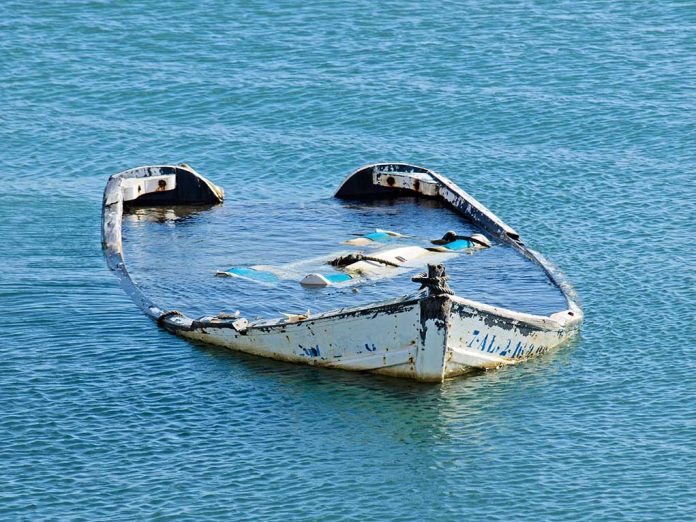
A Chinese militia vessel caught in shallow waters near a Philippine island signals Beijing’s continued aggressive expansion into disputed territories, heightening already dangerous tensions in the strategic South China Sea.
Key Takeaways
- A suspected Chinese militia vessel ran aground in shallow waters near Thitu Island (Pagasa Island), the largest Philippine-controlled island in the South China Sea
- Filipino forces were put on high alert and deployed to assist, only to discover the Chinese vessel had already been extricated
- The incident occurred dangerously close to a Filipino civilian village, approximately 1.5 nautical miles from shore
- The vessel resembled the type of Chinese maritime militia ships involved in previous confrontations with Philippine forces
- This latest incident adds to the increasing number of confrontations between Chinese and Filipino forces in the strategic waterway
Chinese Vessel’s Suspicious Grounding
A Chinese vessel ran aground Saturday in stormy weather near Thitu Island, the largest of nine islands occupied by the Philippines in the contested South China Sea. The ship’s presence immediately triggered security concerns among Filipino forces stationed in the area, who responded by raising their alert status. Military officials noted that the vessel bore a striking resemblance to the Chinese maritime militia ships that have been involved in numerous confrontations with Philippine forces in recent years, raising questions about its true purpose in waters so close to the Philippine-controlled island.
“MANILA: A Chinese ship ran aground in stormy weather in shallow waters off a Philippines-occupied island in the disputed South China Sea, prompting Filipino forces to go on alert, Philippine military officials said on Sunday Jun 8,” said Philippine military officials
The incident is particularly notable given Thitu Island’s strategic location. The island sits merely 12 nautical miles from Subi Reef, which China has transformed into a heavily militarized artificial island base. This proximity highlights the ongoing territorial contest between China and the Philippines, with both nations claiming sovereignty over various features in the South China Sea. The Philippines has maintained control of Thitu Island for decades, even establishing a small civilian settlement there, while China continues its pattern of aggressive incursions into waters surrounding Philippine-held territories.
Philippine Response and Security Concerns
When Filipino villagers reported the Chinese vessel’s presence just 1.5 nautical miles from their community, Philippine military and coast guard personnel quickly mobilized to assess the situation. Initially preparing to offer humanitarian assistance, they discovered upon arrival that the vessel had already been freed from the shallow waters. No details were immediately available regarding potential injuries among the crew or damage to the ship, leaving questions unanswered about the circumstances of both the grounding and the subsequent extraction of the vessel.
“The alertness of our troops is always there,” said Col. Xerxes Trinidad. “We tried to provide assistance as professionals.”
The Philippine military maintained a professional posture throughout the incident, reflecting the delicate balance required when navigating the tensions in the disputed waterway. While the grounding may have been caused by the stormy weather, as noted by Filipino officials, the identity and purpose of the vessel remain concerning given China’s well-documented pattern of using its maritime militia to assert territorial claims. These so-called fishing vessels often operate in coordination with China’s coast guard and navy to maintain presence in disputed waters, effectively advancing China’s territorial claims through persistent occupation.
Broader Geopolitical Implications
This incident occurs against the backdrop of increasing confrontations between Chinese and Philippine forces in the South China Sea. China claims virtually the entire strategic waterway, issuing maps with a controversial “nine-dash line” that encompasses most of the sea, including waters and features claimed by the Philippines, Vietnam, Malaysia, Brunei, and Taiwan. The United States, while not making territorial claims, has firmly committed to defending the Philippines, a treaty ally, if attacked in these disputed waters – placing the South China Sea at the center of growing US-China tensions.
“They got worried because the Chinese were so close but it was really the strong wind and waves that caused the ship to run aground,” said MP Albayda
The South China Sea remains one of the world’s most contested maritime regions, with China building artificial islands equipped with military installations to solidify its territorial claims. These actions have drawn international condemnation, including a landmark 2016 ruling by an international tribunal that rejected China’s expansive claims. Despite this ruling, China has continued its aggressive tactics, including harassing Filipino supply boats, blocking access to features like Second Thomas Shoal, and maintaining a constant presence of coast guard and maritime militia vessels throughout the region.














